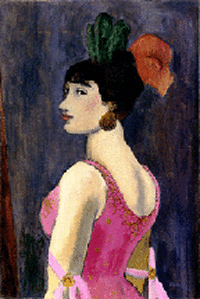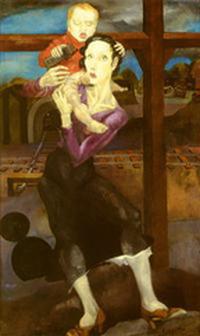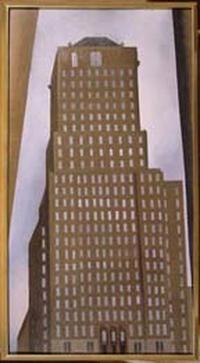 | OCMA (Orange Country Museum of Art) Villa America: American Moderns, 19001950 http://www.ocma.net |
|
Charles Demuth |
Stuart Davis |
Arthur Dove |
|
Philip Evergood |
Georgia OKeeffe |
Grant Wood |
Villa America explores the evolution of American art through masterpieces of Americas foremost artists of the first half of the 20th century. The exhibition begins with a look at key American modernists working in Europe and New York during the first quarter of the century. In these early years, artists such as Stuart Davis, Charles Demuth, Arthur Dove, Marsden Hartley, Gerald Murphy, and Georgia OKeeffe, to name just a few, were reshaping American art. In the early 1900s many of these artists traveled abroad, where they embraced experimentation to transform traditional subject matter into avant-garde statements of personal expression. The exhibitions title is taken from the name of Murphys home in southern France, which served as a gathering place for American and European modernists alike. Symbolizing the creative cross-germination spawned by artists, writers, and other cultural movers and shakers during these critical years, Villa America is also the title of a Murphy painting in the exhibition. After World War I, as New York began to eclipse Europe as the destination for creative people, American artists returned, and many artists from abroad moved to New York.
This extended period of artistic innovation largely came to an end in the 1930s, following the stock market crash, which ushered in a more sober, realistic mode with themes drawn from regional values and a new sense of social responsibility. Artists such as Romare Bearden, Paul Cadmus, Philip Evergood, Philip Guston, Reginald Marsh, and Ben Shahn celebrated and critiqued the American Scene, creating powerful images of everyday American life. In the 1930s and 1940s American Regionalists John Curry and Grant Wood championed a nationalistic art that emphasized agrarian values and the search for American roots. Artists Ralston Crawford, Charles Sheeler, and Niles Spencer, among others, embraced a form of classical realism to celebrate the American landscape in their paintings of the period.
The first section of the exhibition includes more than 20 paintings from the early Villa America yearsfrom the first wave of American modernists who traversed the Atlantic and explored new avenues of expression opened up by their European counterparts, to a second and larger wave of progressive artists who emerged following the Armory Show, many of whom exhibited with Alfred Stieglitz at his famous 291 Gallery. In addition to paintings by Davis, Demuth, Dove, Hartley, OKeeffe, and Murphy, this gallery also includes works by Yasuo Kuniyoshi, Stanton Macdonald-Wright, Morgan Russell, Morton Schamberg, and Max Weber.
As the late 1920s and the 1930s witnessed a change of mood in this country, a significant number of artists felt the need to return to an older American Scene tradition of realism and social commentary. In New York, painters such as Walt Kuhn and Reginald Marsh chronicled the intense vitality of the city, depicting the fantastic range of activities and types of its diverse residents. Otherssuch as Peter Blume, Paul Cadmus, and Philip Evergoodcombined social criticism with caricature in paintings that radiated the sexual and psychological energy that helped carry many Americans through these difficult years. Throughout the country, artists became interpreters of America; the American Scene section of the exhibition also features stellar works by two of Californias most expressive midcentury painters, Elmer Bischoff and David Park.
A strong regionalist movement in painting was also one of the results of the Depression, and it can be seen as a grassroots reaction to the cosmopolitanism of the preceding two decades. Grant Woods painting Return from Bohemia (1935), which gives its name to this section of the exhibition, perfectly captures the endorsement of rural life and local customs. At the same time, an artist such as Charles Sheeler, who had experimented with Cubism earlier in the century, brought a photographic clarity and realism to his work of the 1930s and 1940s. Other artists working in a highly realistic modesuch as Ben Shahn, Bernard Perlin, and Andrew Wyethare also well represented in this compelling section of the exhibition.
In addition to offering a chronological overview of American art of the first half of the 20th century, Villa America highlights a selection of major figurative works that span the entire period, from early American masterpieces by Robert Henri and George Luks to midcentury nudes by Milton Avery and Andrew Wyeth. Henris Edna Smith (Sunday Shawl) (1915), a portrait of a striking redhead, captures his sitters sensuality with directness and painterly spontaneity. The curious monumentality of Averys Seated Nude (1940), in contrast, heralds the radical streamlining of form that preceded the emergence of Abstract Expressionist painting at midcentury.
Finally, the exhibition includes a gallery devoted to striking self-portraits by Paul Cadmus, Arthur Carles, Joseph Stella, and George Tooker, together with powerful portraits by Stuart Davis, Alice Neel, Morgan Russell, David Smith, and Pavel Tschelitchew of friends, acquaintances, and other notable sitters





